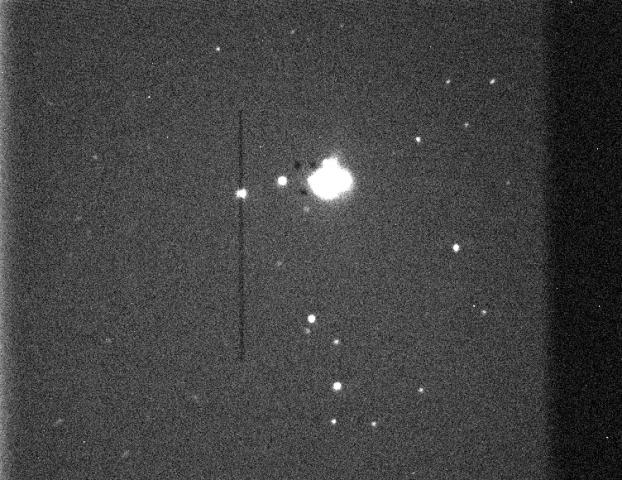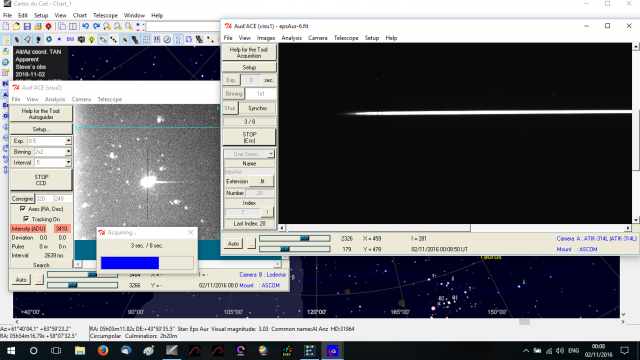› Forums › Spectroscopy › Finding/Guiding with a Lodestar
- This topic has 9 replies, 5 voices, and was last updated 7 years, 11 months ago by
 John Coffin.
John Coffin.
-
AuthorPosts
-
2 November 2016 at 5:33 pm #573617
 Tony RoddaParticipant
Tony RoddaParticipantGents,
If anyone’s interested the “Starlight Live” software from Starlight Xpress renders the Lodestar images really well to the point where even rough thresholding and balance/contrast adjustment reveals the slit.
Starlight Live doesn’t guide though, so…
I’ve used the Lodestar/Starlight for spotting & placement and a QHY+50mm finder/guider with PHD2 for guiding. There’s very little flexure because the guider is rigid (a Celestron) and the spectro is relatively close-coupled. It worked very well last night to capture a mag 11 star without too much hassle and I think it can be refined.
The attached file was a two second frame. The star on the slit is mag 9.2. The region is around RA 05 34 58 and Dec +09 56 27. I believe I can see below mag 13 on this frame. Longer exposures should produce better results.

Regards
T
Attachments:
2 November 2016 at 8:20 pm #577579 Andy WilsonKeymaster
Andy WilsonKeymasterThat is a decent guide image Tony. I find that for good results the target star has to be bang on the slit. This is not just to get the maximum number of photons through the slit, but also to avoid sampling parts of the star’s image which may have been colour dispersed by the atmosphere.
Cheers,
Andy
3 November 2016 at 3:55 pm #577583 Tony RoddaParticipant
Tony RoddaParticipantThanks Andy. I know my early attempts suffer from CA.
At 235mm aperture at f6.3 I’ve never had the target star ‘disappear’ in the slit. I suspect it’s a function of image scale, focusing (psf) and threshold for the displayed image (?). Once I get these maximized I’ll concentrate on guiding to the point where I can hold that target where I want it.
It seems to be perverse that the smaller/fainter the target the less CA I’ll suffer – given accurate guiding.
Rgds
T
3 November 2016 at 6:05 pm #577585 Robin LeadbeaterParticipant
Robin LeadbeaterParticipantHi Tony,
With your setup of 235mm aperture and f6.3, the star image size FWHM with 3 arcsec seeing will be 26 um so slightly larger than the slit width so there will be a small amount of the star overlapping the slit and it will not completely disappear unless your seeing is very good. You should see a significant drop in brightness though as the star crosses the slit. The trick is not to over expose the guide star image. Take a look at the short videos on this page of Christian Buil’s. It gives an idea of what you should see when correctly (fente3.wmv) and over exposed (fente4.wmv). (In French but Google translates well.)
http://www.astrosurf.com/aras/slit/method.htm
If you still do not see the star drop into the slit, your guide camera may not be precisely focused on the slit. This should be checked first before trying to focus the telescope.
Cheers
Robin
3 November 2016 at 8:17 pm #577587 Steve CuthbertParticipant
Steve CuthbertParticipantNice clear image that Tony, haven`t tried that software. Sometimes I can`t always make out the slit with some software I`ve been using with my Lodestar but one I`ve been having success with lately is Audela the French freebie scope/ccd software although I haven`t quite got the guiding sussed out yet. This is a grab from last night.

cheers
Steve
4 November 2016 at 10:56 am #577588 Tony RoddaParticipant
Tony RoddaParticipantNice one Steve. Do we need a shared site to deposit our attempts?
I’d love to do some bench-marking to test what I’m doing?
(That is using other observers’ images/ISIS files to see what I should be doing…
Regards
T
4 November 2016 at 11:01 am #577589 Tony RoddaParticipant
Tony RoddaParticipantThanks for the pointers Robin. I’ll check out CB’s website.
I’d recognized the relationship of focusing wrt to star size, etc. It just takes a bit of practice!
One question if I may. I assume that if (and I say “IF”) my seeing is less that 3 arcsecs that will reduce the FWHM and hence the spread?
Regards
Tony
4 November 2016 at 12:48 pm #577591 Andy WilsonKeymaster
Andy WilsonKeymasterHi Tony,
The new BAA Spectroscopy Database could well be the ideal place to share and compare results, assuming people have reached the stage of producing 1D fits files from ISIS.
I’m just looking at making a final tweak before go-live. This would be to add a “flat field” flag. Though in theory all spectra should be flat fielded before submission, there may be cases where this is not possible, hence why we might want to record that information.
I’ve been busy since the workshop, so I’ve not had a chance to work on this change. If I can’t find the time to do it within the next few days then we’ll probably go-live without it to avoid further delay.
Best wishes,
Andy
5 November 2016 at 6:53 pm #577605 Robin LeadbeaterParticipant
Robin LeadbeaterParticipantHi Tony,
If there is any starlight overspilling the slit then yes, any improvement in the seeing will reduce that and a higher percentage of the light will get through the slit into the spectrograph. (The spectrum resolution remains unchanged though as this is determined by the slit width. This is different from slitless systems like the Star Analyser where you always get all the light but poor seeing reduces the resolution)
Cheers
Robin
31 January 2018 at 6:21 pm #579031 John CoffinParticipant
John CoffinParticipantThanks for the above advice. I’ve also installed Starlight Live to use with a Lodestar to make a sensitive electronic finder.
-
AuthorPosts
- You must be logged in to reply to this topic.
